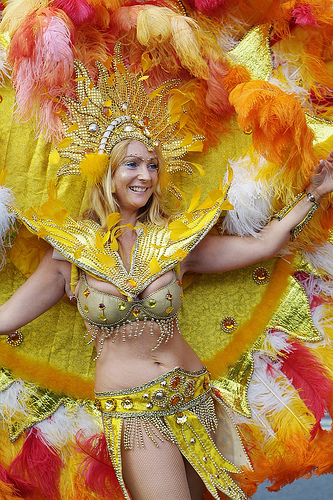Notting Hill Carnival 2012
The 2012 Notting Hill Carnival takes place on the 26th and 27th of August, Sunday the 26th being children’s day and the 27th the carnival for the adults. The carnival fills the streets of West London with sound and colour and of course the aromas of some fabulous food too. The Notting Hill Carnival is an August Bank Holiday Tradition and sees London holding the biggest street festival in Europe. Visitors to the city can expect to see vibrant colours, hear calypso music and taste a variety of Caribbean food available at plenty of food stalls. This is one big party and absolutely everyone is invited! Incredible floats, fabulous costumes and dazzling performances will entertain and thrill the crowds in what has to be the city’s most popular annual events.

Carnival Timetable
The festival traditionally kicks off with a steel band ‘battle of the bands’ competition on the Saturday, raising everyone’s energy ready for the start of the carnival proper on Sunday when the children take to the parade route. The children follow a shorter parade route than the adults, but they still throw themselves into the costume and dance. The costumes are always incredible for all of the performers and carnival participants, and Sunday also sees the prizes awarded for the most incredible and innovative costumes.
The main parade takes place on Bank Holiday Monday when the dancers and musicians take to the streets along with the incredible decorated floats. Come the early evening the floats leave the city streets and in their wake the parties continue. The festival is just as famous for its incredible after carnival parties as it is for the amazing parade. This year’s parade is claimed to be bigger and better than anything held previously, which will be quite something to see.
Parade Route
The parade follows a traditional route, following a loop around the streets of West London. It starts on the Great West Road before moving on to Chepstow Road, then to Westbourne grove and finally onto Ladbroke Grove. The route of the parade is lined with traditional and contemporary steel bands, sound systems that will be blasting out carnival music and there will be different performers positioned along the route of the parade.
Visitors are advised to use public transport only to get to the carnival venues, and to bear in mind that when some tube stations become overcrowded they will be closed down until the numbers of people subsides, your best bet is to wait for the station to re-open rather than try and find an alternative route to your destination.
Carnival History
Originally viewed as an extension of the Trinidad Carnival it first took place in London in 1964. In the early days the carnival was attended by around 500 people who would leave their houses and celebrate the diversity of the city of London. These days there are hundreds of thousands of people drawn to the carnival annually, with the numbers increasing year on year. This year there are set to be over 50,000 individual performers taking part with around two and a half million carnival goers expected to descent on the city.

